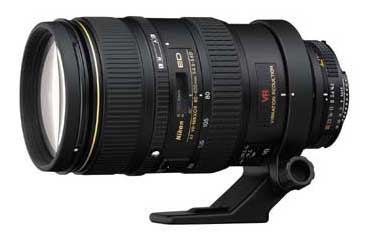Nikon 80-400mm f/4.5-5.6D ED VR AF Nikkor

This super telephoto zoom from Nikon costs around £1168 and has a Vibration Reduction system that should allow hand-held shots to be taken at shutter speeds thee stops lower than without. The lens is an older design, and such doesn't have a motor built-in. This means owners of Nikon's entry-level DSLRs, such as the Nikon D40, D60, D3000 and D5000 will only be able to focus this lens manually.
Most of the main third party manufacturers offer lenses in this range of differing specification. The closest in terms of features would be Sigma's 120-400mm lens, which costs around £600. It also has Optical Stabilisation, but importantly has a silent focusing motor built in, so will focus on Nikon's entry level bodies. Sigma also do a 150-500mm lens with optical stabilisation and a silent focusing motor for around £695.
Tamron's only super-telephoto offering is their 200-500mm F/5-6.3, which costs around £865. This lens doesn't have Vibration Compensation and the built in motor isn't a silent one.
Tokina offer an 80-400mm F/4.5-5.6 lens, which costs around £570 and is currently the smallest and lightest in its class. However this lens doesn't have Vibration Reduction, or a silent focusing motor either.
Nikon 80-400mm f/4.5-5.6D ED VR AF Nikkor: Handling and features
Released back in 2000, this venerable lens feels as though it is built to last although weighing only 1210g without the tripod foot attached it isn't a heavy lens for its size. Much of the exterior is constructed from high quality plastics, rather than metal, which helps to keep the weight down. It isn't an overly large lens either, being only slightly larger than Nikon's 70-300mm VR lens. The zoom range, VR and reasonable weight may make this a perfect super-telephoto companion for those on the move.
The removable tripod foot is cast from magnesium, so is also very lightweight, yet strong. The way the collar attaches to the lens means that it cannot be removed without taking the lens off the camera first, which I found a pain when switching between shooting from a tripod and hand-held, as the foot gets in the way of the zoom ring.
Autofocus is driven by a screw on the camera body, rather than a motor in the lens as with more recent optics from Nikon. It is not an internal focus design either, the lens extends by about 1.5cm at its closest focus. That means the screw-driven mechanism is moving an awful lot of heavy glass around, which contributes to the relatively slow focusing speed. Starting at the closest focusing distance, the lens takes just under two seconds to lock onto a target four metres away in good light. In those two seconds the thing you were trying to focus on could have gone. A focus limiter switch is provided to prevent the lens from hunting through the entire focus range. Enabling it stops the lens passing the five metre point, whichever side of that you're currently set to.
There is no full-time manual focus override either. Nikon have attempted to make switching between manual and auto focus as quick as possible by allowing the M/A switch around the barrel to be unlocked, so it can be changed with a quick flick of the wrist. It can still be locked in place if you worry about it accidentally ending up on manual when you really need auto, and vice-versa. I found the control a bit fiddly to use in practice though. I found it needs a good shove to ensure that the appropriate setting is selected.
This was one of Nikon's first lenses with Vibration Reduction, and it lacks the normal and active mode selector switch, and automatic tripod detection of later models. There are two ways for the VR to be engaged, either just while the shot is being taken, or from when the shutter button is lightly pressed. When it is set to engage just as the shot is taken, you don't get the impression of the VR working through the viewfinder and as a result I didn't find it as effective in this mode.
Nikon 80-400mm f/4.5-5.6D ED VR AF Nikkor: Performance
For this review, the lens was tested on a Nikon D700 using Imatest.
At 80mm, the lens produced good resolution across the frame at nearly every aperture, only dropping a little at f/4.5. To be honest I expected better from a £1100 Nikon lens, so had to test the lens three times to ensure the resolution being recorded was correct.
Zooming the lens to 200mm improves the quality at maximum aperture to very good levels in the centre of the frame, and still good towards the edges. Peak performance at this focal length is achieved at F/8, where the quality towards the edges approaches very good levels too.
The results at 400mm, again are disappointing for a lens of this calibre. Wide open at F/5.6, the results are acceptable, but certainly not stunning. Stopping down does improve the sharpness. Peak performance is at F/11, where the centre resolution is good.
Resolution at 80mm

Resolution at 200mm

Resolution at 400mm

Just as with the resolution, the lens control of chromatic Aberrations is best in the middle of the zoom range, and at smaller apertures. At 80mm and f/4.5 fringing covers an area of 0.86 pixel-widths towards the edges of the frame, which should be acceptable in normal shooting conditions, but may show in higher contrast situations. Zooming to 200mm reduces colour aberrations to extremely low levels and then extending the zoom to 400mm increases the level of fringing to much more noticeable levels. At 400mm and f/5.6, fringing exceeds 1.1 pixel widths towards the edge of the frame, which will be noticeable, especially in high contrast situations.
Chromatic Aberrations at 80mm

Chromatic Aberrations at 200mm

Chromatic Aberrations at 400mm

For a lens with such a modest maximum aperture, light falloff towards the corners of the frame is quite strong. At 80mm and f/4.5, the corners are 1.4stops darker than the image centre. The lens needs to be stopped down to f/8 for even illumination here. At 400mm the level of vignetting improves, but the corners are still 1.2 stops darker than the image centre at f/5.6.
At 80mm this lens suffers with quite pronounced barrel distortion. Here Imatest recorded 1.94% barrel distortion. At 400mm, the strong barrelling is replaced with strong pincushion distortion. Imatest recorded 2.22% pincushion distortion. Luckily the shape of the distortion is uniform at both ends of the zoom, so this will be quite easy to correct in image editing software afterwards if necessary.
 |
 |
Flare and ghosting aren't really much of an issue with this lens. Strong point sources of light within the frame may cause a little flare, but only in extreme circumstances. Image contrast appears to be well preserved in these conditions also. The deep circular hood supplied with the lens does a great job of shielding the front element from extraneous light. With it attached, I saw no issues with light sources outside the frame. Without the hood, the lens still performs well at controlling flare and retaining contrast.
Nikon 80-400mm f/4.5-5.6D ED VR AF Nikkor: Verdict
 Nikon appear to be in the middle of revamping their line of professional quality lenses at present, and I would imagine this focal range will be high on their list.
Nikon appear to be in the middle of revamping their line of professional quality lenses at present, and I would imagine this focal range will be high on their list. In my opinion, this lens could sorely do with an update, optically, as well as with the design in order for it to fully justify the £1100+ price tag.
Nikon 80-400mm f/4.5-5.6D ED VR AF Nikkor: Pros
 Good build quality
Good build quality Vibration reduction
Vibration reduction Not too heavy
Not too heavyNikon 80-400mm f/4.5-5.6D ED VR AF Nikkor: Cons
 Optical performance not as good I I would expect from a lens of this calibre
Optical performance not as good I I would expect from a lens of this calibre Slow autofocus
Slow autofocus Fiddly manual/autoocus control
Fiddly manual/autoocus control  Chromatic aberration at 400mm
Chromatic aberration at 400mm | FEATURES |  |
| HANDLING |  |
| PERFORMANCE |  |
| VALUE FOR MONEY |  |
| OVERALL |  |
Nikon 80-400mm f/4.5-5.6D ED VR AF Nikkor: Lens specification
| Price: | £1168 |
| Contact: | www.nikon.co.uk |
| Filter size: | 77mm |
| Format: | Full-frame and APS-C |
| Construction: | 17 elements in 11 groups |
| Angle-of-view: | 30°10' - 6°10' |
| 35mm equivalent focal length (on APS-C body): | 120-600mm |
| Internal focusing: | No |
| Image stabilisation: | Yes |
| Minimum focus: | 230cm |
| Maximum aperture: | f/4.5-5.6 |
| Minimum aperture: | f/32-40 |
| Weight: | 1360g |
| Size (lxw): | 171mm x 91mm |
| In the box: | Lens hood, case |
The Nikon 80-400mm f/4.5-5.6D ED VR AF Nikkor costs £1168.99 and is available from Warehouse Express here:
Nikon 80-400mm f/4.5-5.6D ED VR AF Nikkor
Add your message
Login required
Please login here or if you've not registered, you can register here. Registering is safe, quick and free.
Please login here or if you've not registered, you can register here. Registering is safe, quick and free.
photodo Stats
1102 lenses
428 MTF tests
74 in-depth photodo reviews
100+ users join each day
Help the lens community by reviewing or rating a lens today via our lens search
428 MTF tests
74 in-depth photodo reviews
100+ users join each day
Help the lens community by reviewing or rating a lens today via our lens search
Latest Lens Reviews
- Chinon 28mm f/2.8 Vintage Lens Review
- Canon EF 70-200mm f/4L IS II USM Lens Review
- Samyang AF 85mm f/1.4 EF Review
- Sigma 70mm f/2.8 DG Macro Art Review
- Samyang AF 24mm f/2.8 FE Review
- Meike 50mm f/1.7 Review
- Tamron 70-210mm f/4 Di VC USD Review
- Lensbaby Burnside 35mm f/2.8 Review
- Asahi Super Takumar 50mm f/1.4 Review
- Asahi Super-Multi-Coated Takumar 135mm f/3.5 Review
